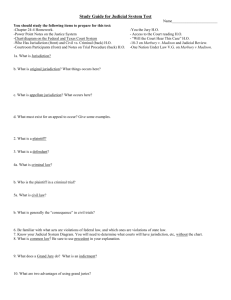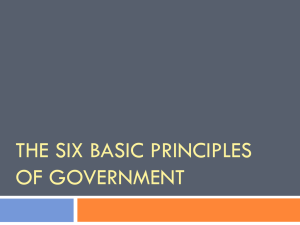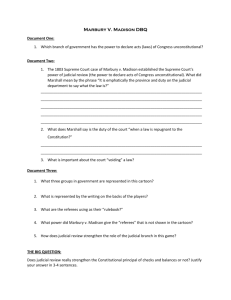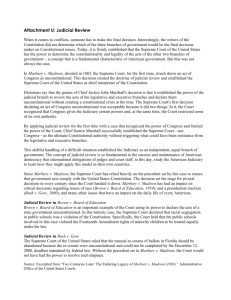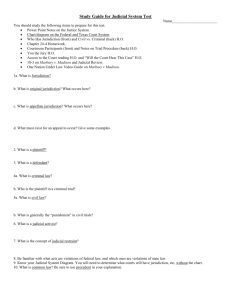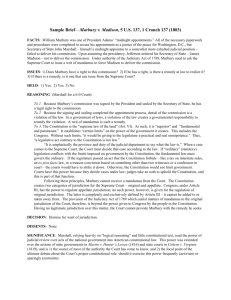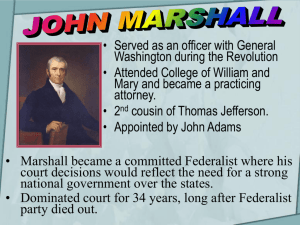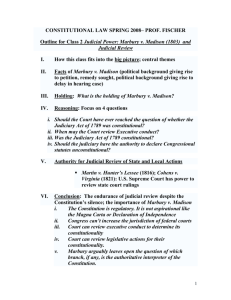No Slide Title
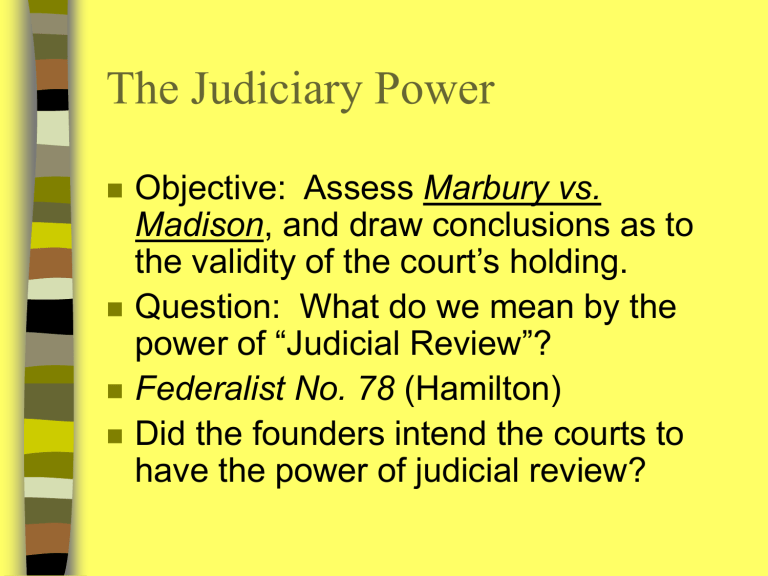
The Judiciary Power
Objective: Assess Marbury vs.
Madison , and draw conclusions as to the validity of the court’s holding.
Question: What do we mean by the power of “Judicial Review”?
Federalist No. 78 (Hamilton)
Did the founders intend the courts to have the power of judicial review?
Marbury vs. Madison (1803)
Background:
President John Adams loses election of 1800 to Jefferson
Adams packs Judiciary with Federalist judges before leaving office. John Marshall (Adam’s Sec. State) delivers the commissions. 17 were unfinished -- left for the incoming Sec. State to deliver.
Madison (Jefferson’s Sec. State) refused to deliver the 17.
Marbury, one of the 17 judges, sues Madison.
Guess who is now Chief Justice…..
James Madison Thomas Jefferson
Marbury vs. Madison (1803)
What was the Potential Constitutional Crisis?
What do you think Marshall should have done?
Marshall writes unanimous opinion:
– Madison violated Marbury’s right to an appointment.
– Courts have power to compel public officials to do their duty (writ of mandamus)……BUT…
– Supreme Court couldn’t act in this case, because Sec.
13 of Judiciary Act of 1789 was unconstitutional
• Unconstitutional because the Act gave Supreme Court
original jurisdiction over writs of mandamus, contrary to the Constitution
– Laws of Congress are subordinate to Constitution
– Supreme Court has duty to interpret Constitution and void conflicting laws (Judicial Review)
Question: Did the Constitution create the power of
Judicial Review? (Read your Constitutions.)
Original vs. Appellate Jurisdiction?
Original Jurisdiction (Art. III, sec. 2, cl. 2):
– “In all cases affecting Ambassadors, other public ministers and consuls, and those in which a state shall be party, the
Supreme Court shall have original jurisdiction.”
Appellate Jurisdiction (Art. III, sec. 2, cl. 2):
– “In all the other cases before mentioned, the Supreme Court shall have appellate jurisdiction . . . . with such exceptions, and under such regulations as the Congress shall make.”
Do you agree with Madison’s interpretation of original jurisdiction under the
Constitution?
Supreme Court Justices (2010)
Samuel Alito Ruth Bader Ginsberg Stephen Breyer Sonia Sotomayor
Anthony Kennedy John Paul Stevens Chief Justice John G. Roberts Antonin Scalia Clarence Thomas
Original v. Appellate Jurisdiction
Jurisdiction – the authority of a court to hear a case (original v. appellate)
Most of Supreme Court caseload is from appeals, not original jur.
– but odds are against getting cert. granted
S.Ct. has wide discretion over cases to hear
– Very few limitations (original jur.)
– Constitution says little; left to Congress
How influence law if case not heard?
– Amicus Curiae (“friend of the court” brief)
– Allows nonlitigants to present arguments
– How interest groups lobby courts
Objective
Assess the arguments for Judicial
Activism and Strict Constructionism, and draw conclusions as to which should be the role of the judiciary.
Judicial Activism vs. Strict Constructionism
What is Judicial Activism?
– Judges should discern general principles of
Constitution & apply them to current circumstances.
– More likely to rule laws unconstitutional
What is Strict Constructionism?
– Judges should only apply rules that are clearly stated or implied in the Constitution.
– Doctrine of Original Intent: Focus on the Intent of the Framers
– More deference to legislature
– Less likely to rule laws unconstitutional
Controversy: Judges making laws and policy?
Question: What should be the role of judges?
Activist Periods Can Coincide with
Profound Changes in Government
Warren Court (1953-1969)
– Expand Civil Liberties & First Amt (Griswold v. CT)
– Malapportionment unconstitutional
(Wesberry v. Sanders)
– School Segregation unconstitutional
( Brown v. Board of Ed)
– Limits on Police and Evidence / Protecting
Defendant rights ( Miranda v. Arizona, Mapp v.
Ohio, Gideon v. Wainwright )
"Everything that I did in my life that was worthwhile,
I've caught hell for."
Burger Court (1969-1986)
– Upheld busing for racial integration
– Allowed suits for job discrimination
– Endorsed affirmative action (U of CA v.
Bakke)
– Struck down state laws preventing abortion
(Roe v. Wade) Chief Justice Burger
Standing: Who May Bring Suit?
Actual Controversy
– Plus ….
Personal Harm demonstrated
– (being a taxpayer not enough to sue government)
Practice cases on worksheet

